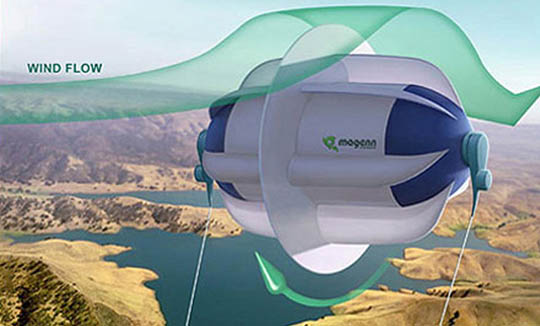



Wind turbines are rotating devices that convert wind energy into mechanical energy. The mechanical energy can be used directly (as in a windmill) by machinery, such as a pump or grinding stones. The mechanical energy can also be converted into electricity (this machine is also called a wind generator, wind turbine, wind power unit (WPU), vertical wind turbine, wind energy converter (WEC), or aerogenerator.)
Wind is a form of solar energy. The rotation of the earth, differences in the earth’s surface and unequal heating of the atmosphere by the sun, cause winds to blow. The earth’s terrain, vegetation and bodies of water change patterns of wind flow. People through the ages have used wind flow or kinetic energy for many useful purposes such as flying kites, powering windmills, sailing, and even generating electricity.
Wind power and wind energy are two terms, which describe how wind can generate mechanical power or electricity. A wind turbine changes the kinetic energy of the wind into mechanical power. This mechanical power can accomplish specific tasks like pumping water or grinding grain. This mechanical energy can also be converted into electricity.
Small or residential wind energy systems usually generate just enough power to meet the needs of a home, small business or farm. They typically consist of one turbine (horizontal or vertical) and range from 400 watts to 500 kilowatts. Small wind systems have proven records of performance and can be relied upon, even in locations with modest winds.
A wind turbine works very much like an old fashioned windmill -- it uses blades to harness the wind’s kinetic energy. The wind turns the blades, which spin a shaft, which connects to a generator and makes electricity. There are two main types of wind turbines -- horizontal-axis wind turbines (HAWT) and vertical-axis wind turbines (VAWT). The helix wind turbine represents a third, new and very different, design.
The horizontal-axis type of wind turbine is the most common wind machine being used today. HWAT wind machines use two or three blades shaped like airplane propellers. These turbines are operated “upwind,” with the blades facing the wind. A basic horizontal wind machine is as tall as a 20-story building and has three blades that spread 200 feet apart.
Vertical-axis wind machines look like a giant two-bladed eggbeater with blades that go from top to bottom. They are called Darrieus wind turbines after their French inventor, Darrieus. The VAWT usually stands 100 feet tall and 50 feet wide. Vertical-axis wind machines make up only a very small percent of the wind machines in use today.
The helix wind turbine has long helical-shaped blade scoops, which catch wind as it blows from all directions. The wind is forced through the turbine into a generator. The turbine generator is connected directly into your home to produce electricity. Since the turbine design catches wind from all directions, it can create smooth powerful torque to spin a generator. The helix wind turbine is mounted up to 35 feet high, in winds as low as 10 mph.
Tags: wind turbines, residential wind turbines, home wind turbines, vertical wind turbines, small wind turbines, vertical axis wind turbines, micro wind turbines, cost of wind turbines, "verticle axis wind turbines", cheap wind turbines, different types of wind turbines, wind turbines for the home, affordable wind turbines, verticle axis turbines,
877-331-1235 | © Copyright DASolar.com.